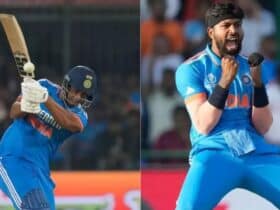The Duckworth-Lewis-Stern, or DLS method has been used many times in cricket matches. While some of the viewers are fully aware of it, others may feel confused at such moments. Remember the 2023 IPL Final when rain had put a halt on the second inning? In that match between Chennai Super Kings and Gujarat Titans, the DLS method came as a game-saver and was utilised to devise a new score. We suggest our readers go through this article to learn more about the DLS method.
What is the DLS method in cricket?
The Duckworth-Lewis-Stern, known as the DLS method, is a mathematical formula designed to calculate and devise a new target score, i.e., the number of runs required to win a particular match. It is predominantly used when the match is interrupted before the second team bats due to bad weather or any other reason.
The DLS method was framed by two English statisticians, Frank Duckworth and Tony Lewis, and thus, it is named after them. The Duckworth-Lewis method in cricket was first used in 1997 and was adopted officially by the International Cricket Council in 1999. Moreover, after the retirement of these statisticians, before the 2015 ICC World Cup, Australian academic Steven Stern made some changes and became its custodian. As a result, in November 2014, his name was added to the method’s title, now known as the Duckworth-Lewis-Stern method.

The history of DLS method in IPL
The DLS method is used by the Board of Control for Cricket in India to determine the sporting process in limited-over matches. It is not new that rain has always been a killjoy in crucial cricket matches. Not only this, many people have condemned the method. In 2016, Stephen Fleming expressed his displeasure when his team, Rising Pune Supergiants, lost the match to Kolkata Knight Rider because of the use of the DLS method. A similar incident is noted when KKR became victorious over Sunrisers Hyderabad due to DLS.
Furthermore, many cricket viewers think that the method is inclined to the team that bats second. It is said that the method was originally formulated for an ODI and not a T20 match. Recently, it was also applied in the IPL 2023 final match between Chennai Super Kings and Gujarat Titans, where GT amassed a huge score of 214 but lost due to the target score being reduced via the DLS method.
How is the score calculated through the DLS method?
The Duckworth-Lewis-Stern method looks at the resources that each team has. These two are the remaining overs and remaining wickets, and the target is revised based on both of them. Throughout the game, a team’s ability to win a game depends on the availability of these two resources combined. The DLS method converts these resources into percentages. While 50 overs and 10 wickets = 100%, 40 overs and 10 wickets = 89.3%, and so on. It is determined by a DLS method calculator chart created by a computer program. The DLS method formula is:
Team 2’s par score = Team 1’s score x (Team 2’s resources/Team 1’s resources).
Final Thoughts
Given these points, the DLS method is an amazing method to calculate the target score, but it has its own flaws. Since the outcome of a cricket match is unpredictable till the last ball and wicket, determining the result prior to that seems biased and has rightfully received criticism. Until the time there is no other method for determination, all you can do is watch the game and pray that it does not rain when your favourite team’s on the ground.

















Leave a Reply